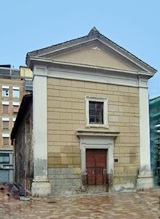


An ancient parish church on this site was used for political meetings from the earliest days of the Commune until ca. 1300.
According to tradition, the parish priest, Don Pietro, habitually railed here against the taxes imposed by Conrad of Urslingen, Duke of Spoleto in the late 12th century. As a result, a blacksmith called Liberotto Liberotti killed the tax collector and led a successful rebellion. Although there is no documentary evidence for these events, Liberotto Liberotti remains the symbol of the independence of Terni.
The old church was destroyed in the earthquake of 1703 and subsequently rebuilt.
The church was deconsecrated in 1930, when the new church of Sant’ Antonio da Padova took over responsibility for the growing parish. It now houses the Mostra Permanente di Paleontologia (Paleontological Collection).
Exterior
The façade dates to the late 18th century.
The side walls (11th or 12th century) survive, as does the base of the original campanile, which provides the foundations for its successor.
There were originally arches on each side of the church, but only part of the one on the right survives.
Incredulity of St Thomas (12th century)

Interior
The church has a single nave and still retains its 18th century decoration.
A number of original frescoes, mostly from the 15th century, have recently been discovered.
Frescoes (1499)
These frescoes, which are signed by “Pietro” and dated by inscription, depict St Sebastian and the Madonna and Child. [Where are they?]
Art from the Church
Madonna and Child (15th century)

